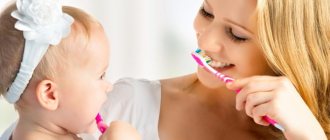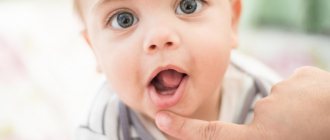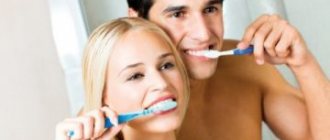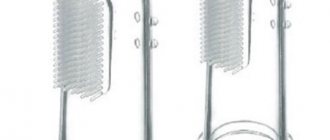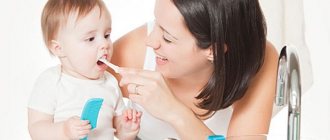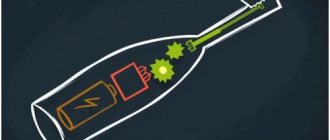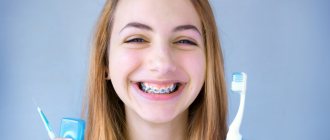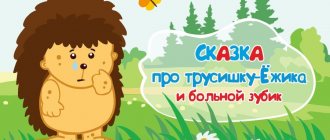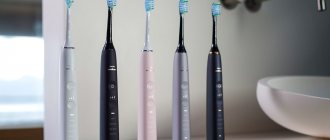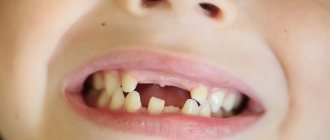Not all parents know how to properly brush their children’s teeth, but The condition of the erupted permanent teeth depends on the quality of care for baby teeth.
. To protect your child from problems with molars, incisors and canines, it is necessary to teach him to brush and rinse his mouth after the very first tooth erupts.
Features of the structure of milk teeth
Baby teeth form in the sixth week of fetal development. Normally there are 20 of them:
- 8 molars;
- 8 incisors;
- 4 fangs.
Temporary teeth consist of the same tissues as permanent teeth:
- dentin (in temporary teeth it is softer and less mineralized);
- enamels;
- pulp.
However, primary incisors, canines and molars have features:
- low crowns;
- large distance between crowns;
- long thin roots that dissolve before the temporary tooth falls out and the permanent tooth erupts;
- thin enamel - only 1 mm;
- wide channels.
The structure of baby teeth is only slightly different from permanent teeth, so they no less need proper care. You can start brushing your child’s teeth after the very first incisor has erupted.
. Early training in hygiene will be an excellent prevention against many dental diseases that can affect the primary incisors, and then the rudiments of the permanent ones formed under them.
If you don’t care for your baby’s teeth or care for them incorrectly, your baby will have to visit pediatric dentists already in the first three years of life. Or he may tolerate drilling rotted teeth with a bur, which is painful and unpleasant for a small child, even with high-quality anesthesia.
Features of jaw development at 8–13 years of age. Changeable bite
The main thing that happens to a child’s teeth at this age is that they change to permanent ones. This condition of the jaw in adolescents is called a mixed bite.
By the age of 3, the child has 20 temporary teeth, which began to grow from the age of six months. They are gradually replaced by indigenous ones (with normal development, complete replacement occurs by 13–14 years). 8–12 chewing teeth also appear, which immediately erupt as permanent teeth.
During the period of change of occlusion, the roots of baby teeth dissolve, preparing the place for new, permanent teeth. The change in bite begins at the age of 6 and lasts for the next 8. The sequence of teeth change is the same for all children, but the boundaries of the periods may vary. The front milk teeth are the first to be renewed - just remember the photographs of first-graders on school rulers! At this time, children's jaws are actively growing, and gaps appear between the teeth necessary to freely accommodate molars - they are always larger than baby teeth. Constant changes in the structure of the jaw will occur in a child up to 14 years of age.
The formation of a bite is a very long and important process, on which the health and appearance of the child in the future largely depends. Therefore, it is necessary that from 6 to 14 years of age he undergoes an annual examination by an orthodontist. The doctor will ensure that the teeth are correctly positioned in the dental arch, and will also monitor their size, shape, and enamel characteristics. It is much easier to track bite deviations in childhood or adolescence than to correct them when the child grows up.
How to properly clean a baby's mouth
Immediately after being discharged from the hospital, you need to start wiping the newborn baby’s gums with a thick gauze swab dipped in water. You can also wet the tampon in:
- chamomile infusion, if the baby does not have constipation;
- bactericidal infusion of sage;
- St. John's wort decoction, as this plant strengthens the gums;
- anti-inflammatory decoction of calendula.
It is not recommended to use decoctions and infusions of herbs to treat the oral cavity of a baby more than 2-3 times a week, as their abuse can lead to allergic reactions.
Maintaining hygiene, which involves treating the oral mucosa with a gauze swab, is necessary for both newborns who are breastfed and those children who are fed artificial formula. Breast milk does not clean the oral cavity, but pollutes it. If you do not sanitize your baby’s mouth after feeding, then pathogenic bacteria will begin to multiply in it, which can lead to infection of the tooth enamel.
POSSIBLE DIFFICULTIES
Sometimes teaching a child to brush their teeth is not as easy as we would like. The following difficulties are possible.
- The baby resists the penetration of the brush into his oral cavity and perceives it clearly negatively. In this case, parents will have to be patient, but persistent. You can buy a bright, beautiful brush, which at first will be perceived as a toy, and also entertain the baby with rhymes and games, trying to evoke positive emotions in him.
- The child may find it uncomfortable to hold the brush. In this case, training (“brush the teeth” of dolls and other toys), as well as classes to develop fine motor skills, will help.
- Children may experience discomfort due to the fact that very rough bristles damage their enamel, in this situation they should replace the brush with a softer one.
It is also important for parents to keep their baby's brush clean, so they should wash it at least once a week. Silicone and polymer models should not be boiled or doused with boiling water; just wash them thoroughly with soap and then let them dry. The service life of the instrument is no more than 2-3 months, however, if the baby has suffered from an infectious disease, then replacement must be made immediately. Also, if the bristles begin to spread in different directions due to overly conscientious cleaning, then the product must be replaced.
At what age should a child start brushing his teeth?
You need to start brushing your baby's teeth from the moment they begin to erupt.
At first, it is better to perform manipulations without paste, carefully treating not only the first tooth, but also the gum itself. You can use a special soft baby brush or a silicone pad that is placed on the parent’s finger. The last device will serve not only as a brush, but also as a gum massager, which will ease the pain from teething.
You should act carefully during the cleaning process, since the gums near the cutting tooth are inflamed and painful, so infants may react poorly to the hygiene procedure. But you cannot refuse it: during teething, local immunity deteriorates, so the risk of infection of the enamel increases.
More details about caring for the oral cavity of a newborn are described in the video:
How to properly brush children's teeth
There are several general rules for high-quality teeth cleaning, depending on the age of the baby:
- A child under one year old should brush his teeth using a special silicone pad, which is fixed on the parent’s index or thumb.
- After a year, you can use a brush with silicone bristles and a special limiter, gradually switching to classic models.
- From the age of three, a regular brush with soft bristles is used. It is important that its surface is covered only by two dental crowns, otherwise the hygienic procedure will not be effective enough.
A baby brush needs to be changed every 3-4 months. If the service life has not yet expired, but the brush has already become rough around the edges, you should change it, since pathogenic bacteria can begin to form and multiply between the bristles.
How to brush the teeth of a child under 1 year old
Six months is the age when parents should start brushing their child’s teeth every day.
From 6 to 12 months, children are cutting teeth, so during this period it is necessary to sanitize their oral cavity very carefully. The baby cannot yet take part in the hygiene procedure, but can already express his dissatisfaction with sounds and gestures, so the adult should focus not only on the dental cleaning technique, but also on the baby’s sensations.
How to properly brush your first teeth
Key cleaning rules:
- the necessary movements should be sweeping: from the root to the top;
- the finger with the silicone attachment should be in the child’s mouth at an angle of 45 degrees to the gums;
- when processing chewing surfaces, the finger with the nozzle is positioned horizontally and cleans the crown with progressive longitudinal movements;
- The inner surface of the teeth is cleaned with short, quick movements;
- The side teeth can be cleaned using circular movements.
There should be about 10–15 movements per tooth. During the procedure, it is necessary to clean not only the dental enamel, but also the inner surface of the cheeks, tongue and gums. You can also brush your one-year-old child's teeth using special dental wipes, which can be purchased at the pharmacy.
Why you need to teach your child to brush their teeth earlier than one year
You should start brushing your baby's baby teeth when the first incisor appears or even before it fully erupts. Complete oral care will help:
- form the correct bite;
- It is good to clean the oral cavity from cariogenic bacteria;
- prevent various diseases, including caries.
How to brush teeth for children over one year old
A child over 1 year old can purchase their first toothbrush with silicone bristles. It costs more than a regular one, but such a waste of money is justified: a brush with silicone bristles will not injure the child’s teeth and will help to thoroughly clean the gums and cheeks. You can use it to clean even your child’s first teeth. However, such brushes quickly become unsuitable for safe use, so they should not be used for a long time.
Rules for caring for a children's toothbrush with silicone bristles
In order for the silicone brush to last longer, you must follow the following rules for its operation:
- Do not boil or even simply pour boiling water over the brush;
- After each use, you should wash it with soap (baby, tar, laundry).
The brush should not be placed in a case; it should be stored in a closed cabinet, in a glass, separately from the brushes of adult family members.
Why is this necessary?
There are several main tasks that are assigned to teeth, or rather, to healthy teeth. Therefore, brushing your teeth is an integral part of any person’s life. Let's look at each reason why you need to brush your teeth daily and, most importantly, correctly.
Why brush your teeth
Chewing food
Proper placement of teeth and their good health not only beautify a person's appearance, but also serve other purposes. In the human digestive tract, the mouth plays the role of the first mechanism. When chewing, food is crushed and soaked in saliva, making its further digestion in the intestines and stomach much easier. If the food you eat is not sufficiently saturated with saliva, this will certainly negatively affect its digestibility. Only those people whose mouths are decorated with healthy and strong teeth can perform thorough processing of the food they eat.
Moreover, food and brushing teeth
Clarity of diction
It is no secret that not only the tongue and lips, but also the teeth are involved in the formation of sounds during conversation. A thinned dentition will not allow a person to speak clearly. Diction can also be negatively affected by improper development of teeth. Even if a person loses only one front tooth, he will eventually develop a lisp. If this happened at a young age, then children may stop communicating with a child who has a lisp. As a result, the child will gradually move away from society and become more withdrawn.
Teeth cleaning
Dental health
Many dental diseases, such as tooth decay, are much easier to prevent than to cure. The same applies to improper tooth growth in children. It is enough just to follow preventive measures and observe the rules of oral hygiene. Ignoring such measures will lead to serious complications, the treatment of which will certainly take much more time and money.
On a note! Dentists note that it is unacceptable for a patient to live with bad teeth, since bacteria in the mouth can easily spread to internal organs. As a result, ignoring a diseased tooth can result in a serious disease of the entire body.
Healthy teeth
Toothpastes for one-year-old children and infants
To start brushing children's teeth using toothpaste, it is not necessary to wait until the child is one or three years old. Most toothpastes are indicated for children over 2 years of age, however, there are a number of manufacturers whose product lines include good fluoride-free toothpastes suitable for children under one year of age. They are completely harmless and can be swallowed. Such products can be found among the brands:
- ROCS
- Elmex.
- Splat.
- Lacalut.
Each toothpaste indicates at what age it is approved for use - you need to brush your child’s teeth only with a product that is not contraindicated for him and is suitable for comprehensive care of children’s teeth.
When starting to brush the teeth of a child under one year old using toothpaste, you need to monitor his reaction. Some babies may develop allergies, so at the first symptoms of a rash or an incomprehensible cough, you should stop using the paste and show your baby to a doctor.
BRUSH SELECTION
For children over one year old, it is important to choose the right toothbrush; it must meet the following requirements:
- presence of a limiter on the handle;
- rubber fluffs.
After 3 years, you can switch to classic models with short handles and soft bristles, the working surface is no more than 2.5 cm. It is desirable to have silicone inserts on the handle, they will help prevent the “tool” from slipping in an unsure child’s palm. When the paste is used, you can consider options in which the area on the bristles is highlighted in color for the placement of the paste.
Teeth brushing technique with toothpaste
You can start brushing your teeth with toothpaste when the child’s first incisor appears, the deadline is one and a half years.
You shouldn’t wait until he develops caries due to lack of proper care.
Brushing procedure with toothpaste:
- a certain amount of paste is applied to a pre-moistened brush;
- the brush is brought at a right angle to the crowns;
- The tooth surface must be cleaned using sweeping movements: from the roots to the tops;
- The inner dental surface is cleaned with short movements, the brush is placed at an angle of 45 degrees;
- the cutting and chewing surfaces of the crowns are processed at the very end;
- after completing the procedure, you should rinse your mouth with water;
- The approximate duration of each cleaning is 2–3 minutes.
2–3 years old is the age when you need to start teaching your child to brush their teeth on their own.
How to reduce the risk of developing caries and not give up sweets
If your child has a sweet tooth or you are simply not ready to limit him, offer him an alternative - lollipops and candies with xylitol.
Xylitol or xylitol is found in the fibers of fruits, vegetables, birch bark and even mushrooms and is not a breeding ground for bacteria. When xylitol is added instead of sugar, it stops the growth and development of caries, since it is not absorbed by cariogenic bacteria, and they die.
Products containing xylitol can be consumed at any age. For children, 2-3 pieces of 100% xylitol chewing gum per day are enough to significantly reduce the risk of plaque and tooth decay.
In addition, chewing gum with xylitol will be useful for children who do not have the habit of actively chewing vegetables or meat. Chewing gum is useful as an additional exercise machine.
Lollipop Miradent XyliPOP (blueberry), 5 pcs.
Lollipops miradent Xylitol Drops mint
Chewing gum miradent Xylitol For Kids strawberry
How to teach a child to brush their teeth
Many children under 1 year old, and sometimes older children, do not want to brush their teeth, expressing their dissatisfaction in every possible way. In this case, it is necessary to attract their attention to the hygiene procedure using one of the following methods:
- buy a bright brush with your favorite cartoon character and toothpaste with a pleasant fruity taste;
- invite your child to brush the teeth of his toys;
- brush your teeth with your child and compete with him in the quality and speed of brushing.
Each parent independently decides at what age to start brushing their child’s teeth and whether to use toothpaste, but delay can negatively affect the baby’s health. Parents should not only brush their children’s teeth, but also teach them how to properly care for their mouth on their own.
Dr. Komarovsky talks in more detail about children’s teeth, caring for them and teaching a child to brush:
Rules for caring for a children's toothbrush
Having figured out when you can start brushing your child’s teeth with toothpaste, and whether the procedure should be carried out in the absence of visible crowns, it is important to familiarize yourself with the instructions for use. A baby’s immune defense is not as strong as an adult’s, so the body is more susceptible to pathological processes caused by pathogens. They multiply not only in poorly cleaned oral cavity, but also in dirty stubble.
Helpful Tips:
- wash the accessory with soap after cleaning to prevent the development of pathogenic microflora;
- replace the product every 2-3 months;
- do not use special covers, since accumulated moisture is a breeding ground for bacterial agents;
- It is better to keep the brush in a glass with the bristles up, and do not allow it to come into contact with objects belonging to other family members.
